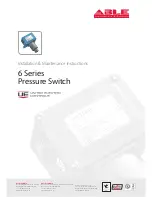
OPERATION
3
page 3.3
RCP–48X
Operations
Section 3
Data Keys: 48 Data Keys are located towards the left of the panel. Data Keys are associated with
sources or destinations in Direct Take mode and levels in the Level Select mode. The source/destination
assigned to each Data Key is configurable from the controller.
Function Keys:
Two function keys are located to the far right of the panel: Protect / Lock and Level
/ Display Address. Each function key works as a toggle; the primary function is listed first, followed by
the secondary function. NOTE: The primary function is executed when the key is held down less
than 2 seconds. The secondary function is executed when the key is held down more than 2
seconds.
The RCP–48X has 2 Modes of Operation:
Direct Take - Selects sources to be switched to the destination controlled by the panel by depress-
ing associated Data Keys. Switch requests are sent immediately. Direct Take is the default mode;
deselecting the Level Select mode will always return you to the Direct Take mode. The Level/
Address Key will not be illuminated if the panel is in Follow or blinking if you have selected
Breakaway level(s).
Level Select - Selects which levels are to be affected when selecting switches in Direct Take mode.
Enter the Level Select mode by depressing the Level/Address key for less than 2 seconds. The
Levels/Address key is illuminated in this mode of operation.
Default Status Level Status: Panel will always display the status of the Default Status
Level.
Default Destination Group: Destination group to be controlled by the panel on panel boot-up.
Default Status Level: The level that will be statused when panel is in Follow operation and status
is not determined by the Group Status (refer to the preceding Status Method description).
Level List: List of levels to be controlled by the panel. Any level not in the assigned Level List will
not be accessible to or affected by panel operations.
Key Assignment List: List containing the assignment of source/destination groups to each of the
Data Keys.
PANEL CONFIGURATION:
Address: Decimal number from 1 to 128 which is used to distinguish each panel on the panel
communications bus. Address must match the dip switch setting on the rear of the panel. Systems
requiring more than 128 panels are possible with enhanced controllers: refer to your Pesa Sales
Representative for details.
Panel Name: Any 8 alphanumeric characters. Currently used only by the controller configuration
program to provide a user-friendly method of referring to each panel.
Priority: Choice of 3 priorities: Master, Supervisory, or Non-Supervisory. Priorities are used when
panel attempts to set or clear a destination Protect/Lock. Only the panel which set a Protect/Lock, or
someone of higher priority can unlock a destination. The default setting is Non-Supervisory.
Status Method: The panel displays status differently based on whether the panel is set for Follow
(changing all levels assigned to panel) or Breakaway (changing only selected levels) operation. In
addition, you may select between 2 methods of displaying status when in Follow (NOTE: these
methods only apply when the panel is set for Follow operation):
Group Status: Panel will display status based on the Source Group which changed the cur-
rent destination. If the panel receives status due to a Breakaway change request, or due to a
change made elsewhere in the system, the panel will display the status of the Default Status
Level (refer to the Controller Operations Manual for more details).















































